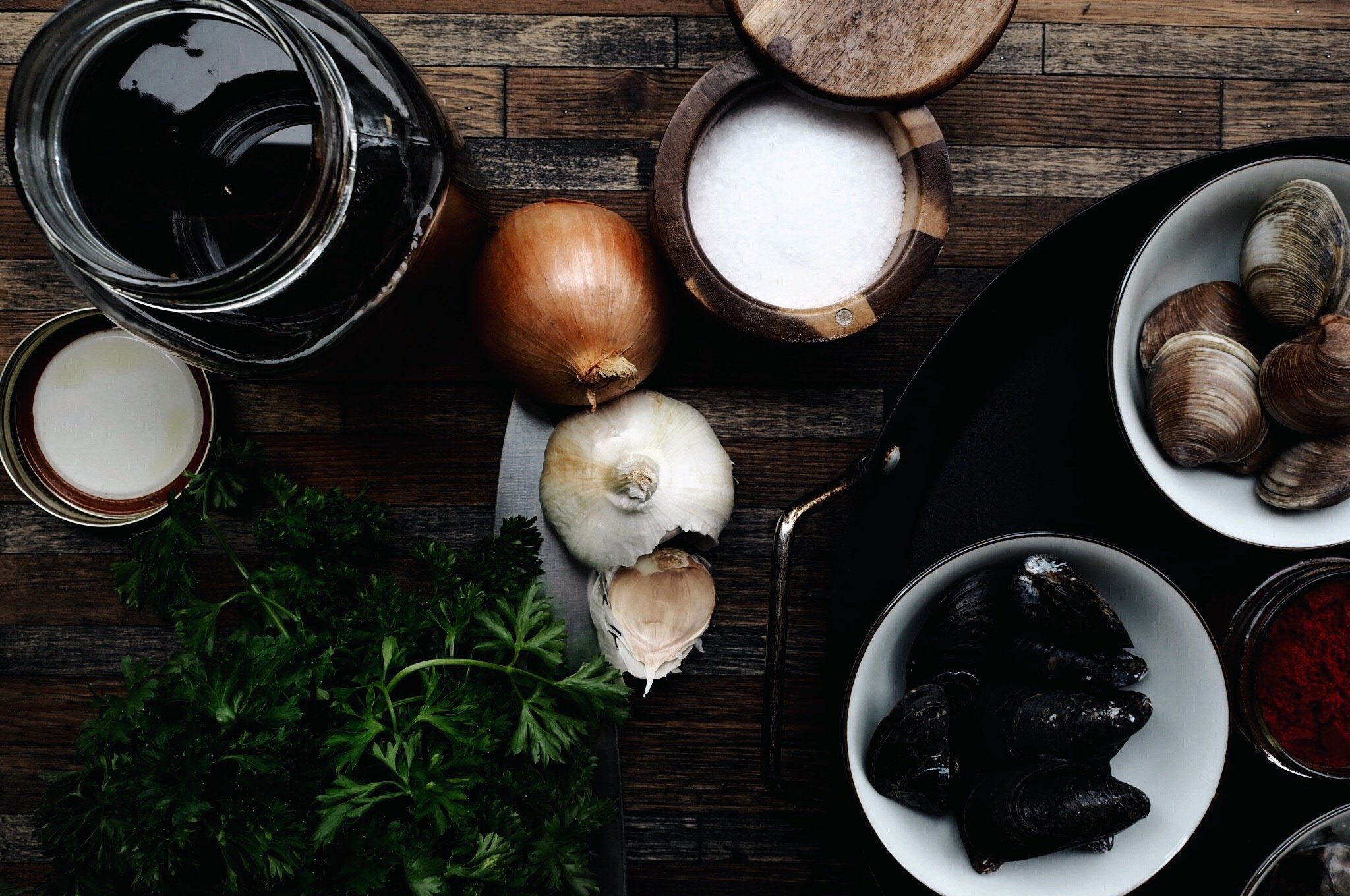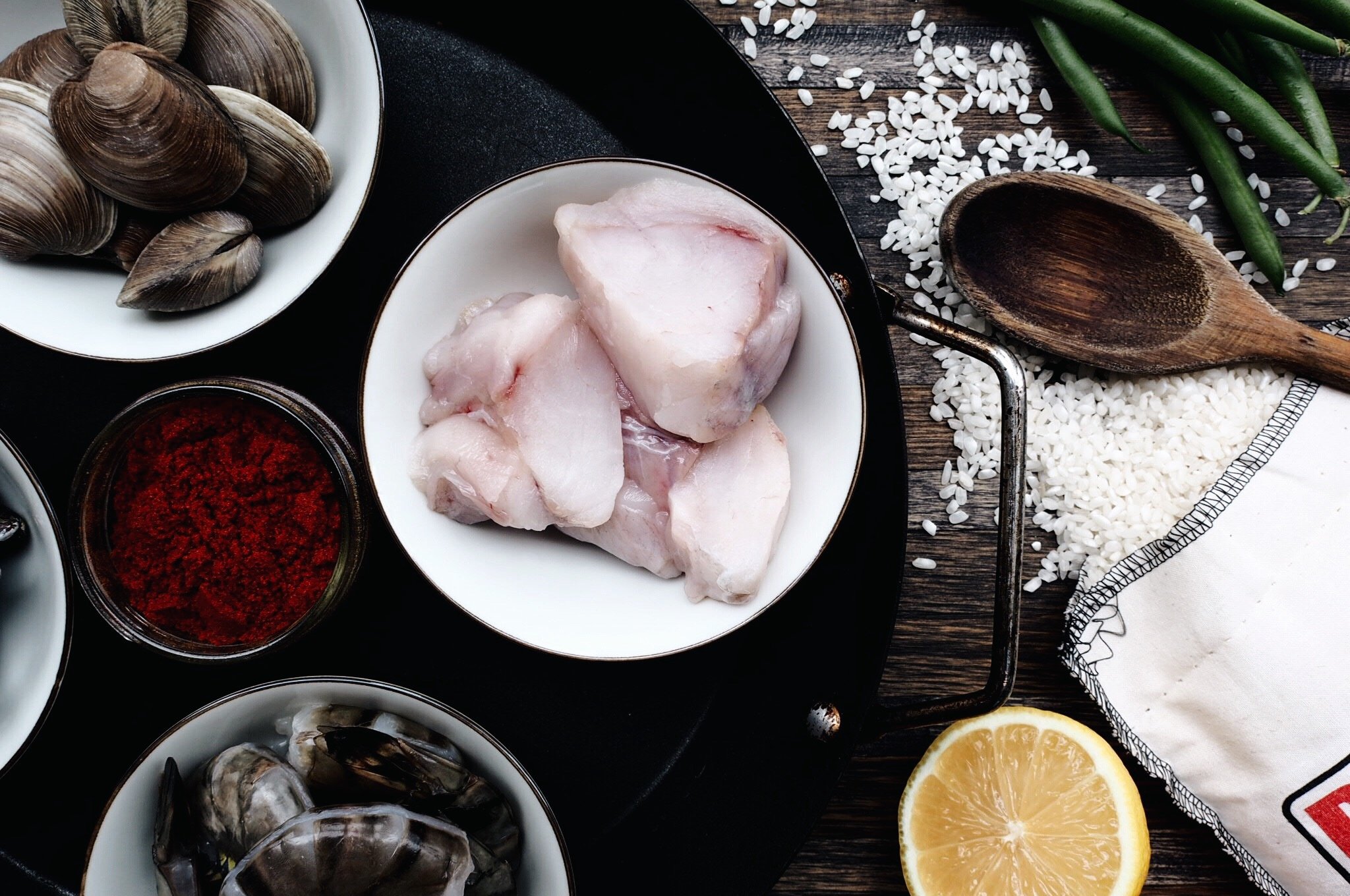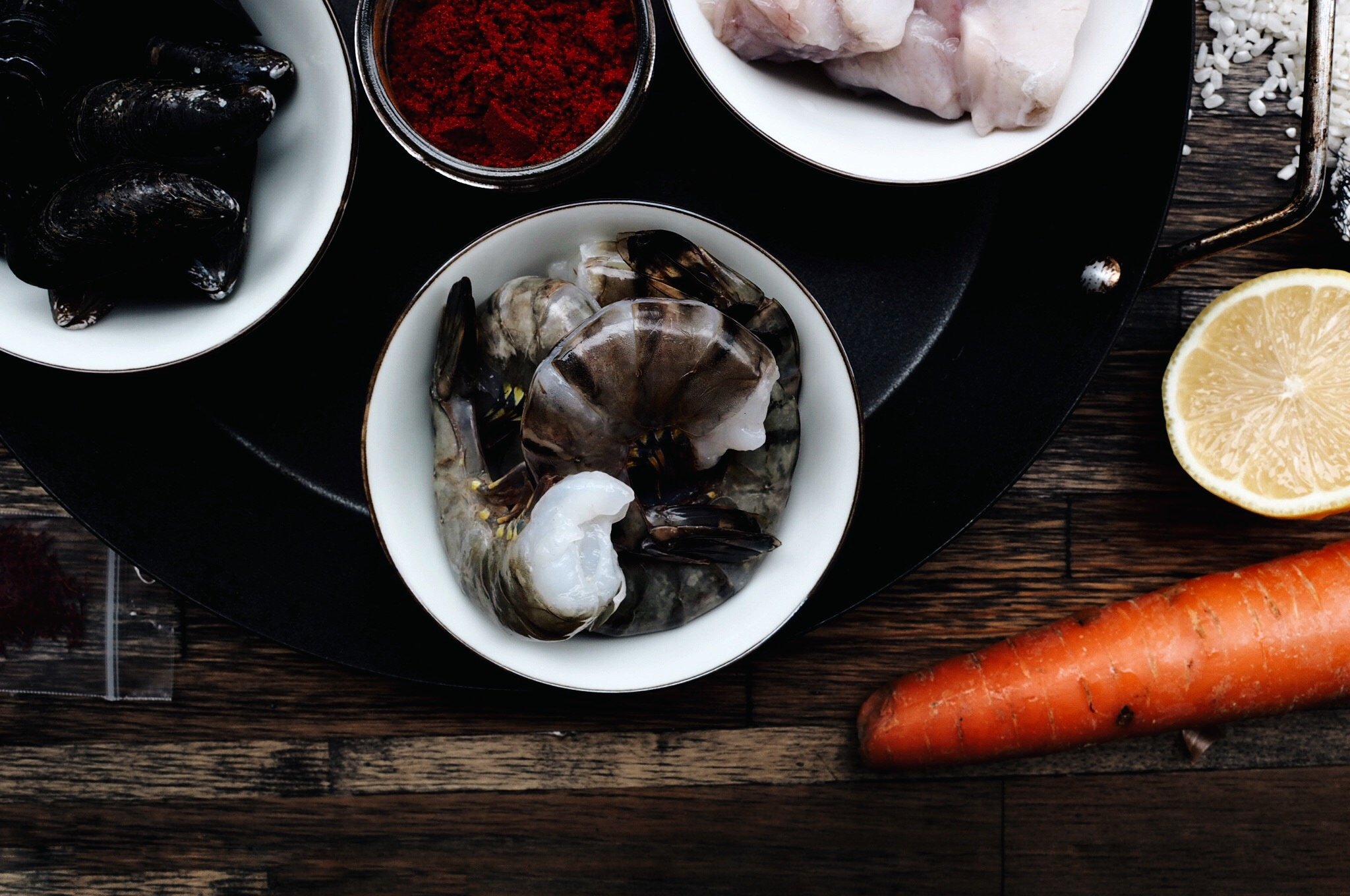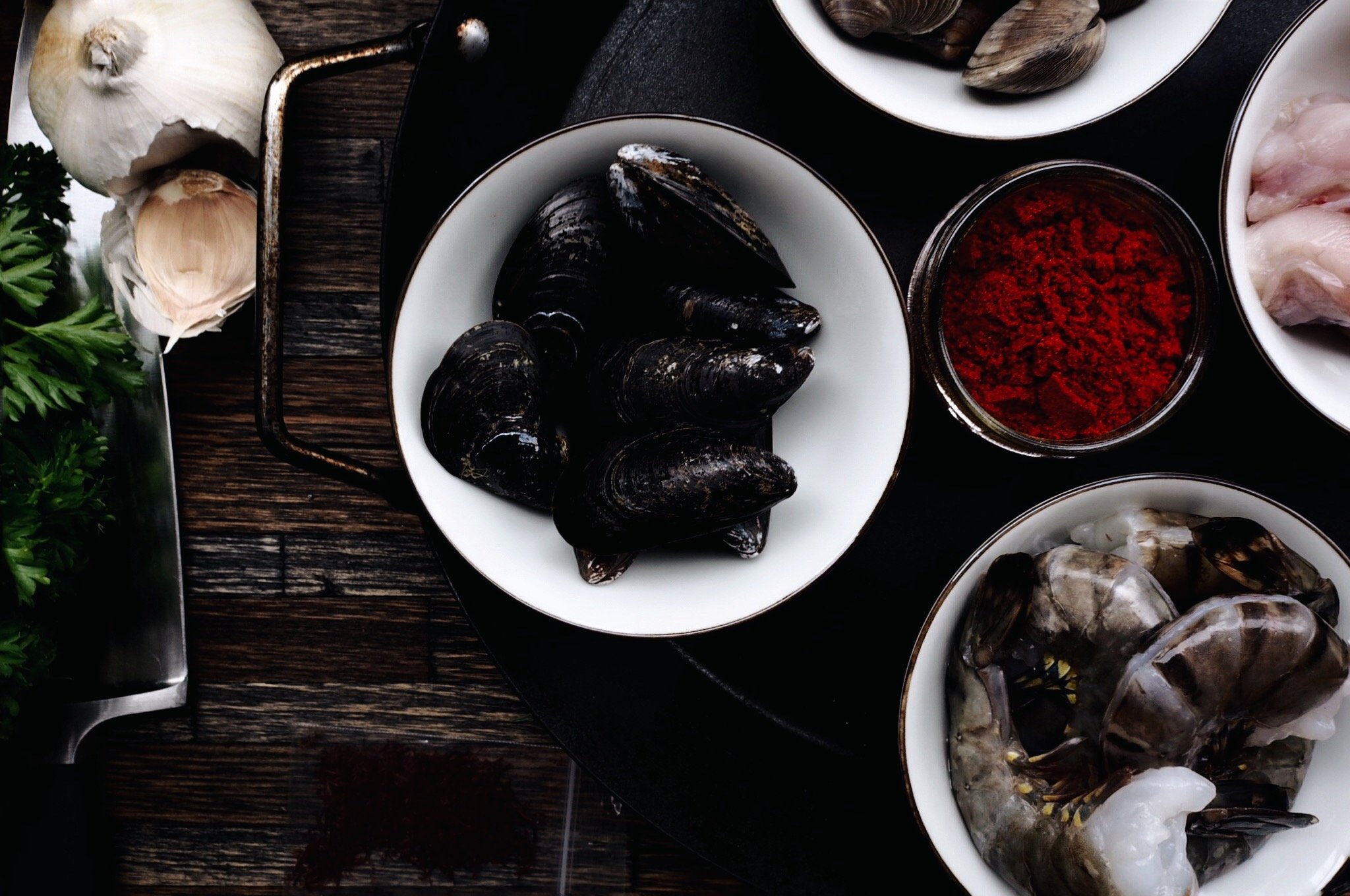The Unapologetic Paella
The best paella I’ve ever had is my Uncle Gerard’s. Growing up in the suburbs of Montreal, it’s really the only paella I was exposed to. His special seafood paella was reserved exclusively for our annual New Year’s Eve family dinner; an event that I, sadly, consistently missed for almost a decade. Meanwhile, over the past 10 years, I’ve tried paella wherever I could find it, and found it mostly to be dry and overcooked with little exception. I didn’t miss family dinner this last New Year’s Eve and when I finally bit into my uncle’s paella after all these years, I was finally satiated. It inspired me to try making it for myself … again. I’ve made an attempt once; it’s a dish that is more so intimidating than it is difficult, in part because it requires the confidence to overcome the fact that no matter what you do, your paella is likely to offend a Spaniard.
Peering through dozens of recipes, the most apparent commonality between them was not the ingredients or the method, but the ongoing debates in the comments section as to whether the dish was authentic enough to even be labeled as paella. Last October, Jamie Oliver made a paella SNAFU that provoked a barrage of hateful criticism from angry Spaniards so intense that it made international headlines. Dubbed “Paellagate”, the offense involved adding chorizo to his recipe. Sacrilege! One comment suggested that instead of “paella” it should be called “rice in a pan with stuff”. Ouch. Should you be tempted to stray from the path of righteous paella-making, there’s even a website, Wikipaella.org. Created by a non-profit organization mandated with the education and recognition of authentic paella, the website contains recipes, a map of certified restaurants (only one of which exists in all of the American continent), and a passionately penned manifesto that ends with “we carry the paella in our heart and we travel with her as far as possible”.
I began to have cold feet; experimenting with paella in the privacy of your own home is one thing, but committing it to online publication exposes you to things worse than trolls: paella purists. So I dug further and further down the Google rabbit hole to better understand what defines a paella and - with the countless variations of it - why tweaking it with ever so much as a sausage would make it grounds for heresy.
A SHORT HISTORY
It is believed that the paella originated in Valencia, Spain in the early 1800’s. While the earliest recipe was published in 1840, the dish had likely already been a countryside tradition long before that, where it was cooked over open fire. Paella is of dual heritage; the Romans crafted the pan, but the rice dish itself was highly influenced by the culinary traditions of the Arab Moors. The Moors brought rice to Spain in early 10th century, which the Spanish eventually adopted as a staple. Around the same time, Arab traders introduced saffron - the Moors’ preferred spice for rice dishes - to the market.
The most common ingredients are also believed to have been influenced by the Moors, and this is partly why Chorizo was never part of any original recipe. Moors, being of Muslim faith, did not eat pork, which is absent from traditional recipes. The original Valencian paella recipe, paella valenciana is made with rabbit, snails, and three types of beans. As other regions adopted the dish, variations began to surface making use of local ingredients. The coastal towns in the east used fresh seafood, creating paella a la marinera (Fisherman’s Paella).
The 1960’s saw a boom in tourism in Spain, and with visitors seeking the iconic dish, cooking methods were adapted to produce smaller servings in a kitchen setting and more crowd-pleasing ingredients were tossed into the mix to create unholy unions. It is around this time that many believe the paella mixta, combining meat and seafood was born, and the rest is history.
ANATOMY OF A GOOD PAELLA
Paella pan
Paella is actually the name for the pan that it is cooked in. The pan is splayed and varies in size, with most standard household pans measuring 16” to 18”, which will feed about 4 people. It is flat and shallow, merely averaging 2“ in depth depending on the size of the pan. There are 2 handles, positioned on either side of the pan. Some will argue that if it is not made with a paella pan, then it is not paella.
Sofrito
Paella starts with the sofrito; a mix of tomatoes, onions, garlic, and paprika that is cooked down to form a jammy sauce. Sofrito serves as a base for many soups and stews. It is essentially the Spanish equivalent of the French mirepoix or Cajun holy trinity. Making the sofrito is often the first step to cooking paella, with the exception of browning meats when applicable.
Rice
The rice in a good paella should be drier than an Italian risotto, but not so dry that it is tough. The short-grained bomba or Calasparra rice are the most widely used rice for paella. However, in Valencia medium-grain varieties, such as bahia and sepia (which are difficult to find in North America) are gaining favour for their ability to absorb more flavour. One cardinal rule of paella-making is that the rice is not to be stirred once it has been evenly distributed. While a lot of emphasis is put on the rich and tasteful ingredients that can go into a paella, a good paella is marked by the quality of its rice. The ratio of rice to meats and vegetables should be balanced, if not tipped more towards the rice, so as not to overcrowd the pan to the point of compromising its even cooking.
Socarrat
The finishing touch to a good paella is the socarrat. It is the crispy, golden brown layer of rice at the bottom of the pan that is achieved in the last minutes of cooking. The socarrat gives added contrast to the texture with a nice roasted finish.
WHY YOUR PAELLA (AND MINE) WILL LIKELY OFFEND SOMEONE
If I am not offending Spain with my ingredients, I am likely offending her with my methods. And you will, too. But it’s not for lack of trying.
Paella was created in a specific environment and with specific tools that are not conducive to a typical Canadian lifestyle. The dish was meant to be cooked outdoors, over an open flame; here it is winter 9 months of the year. Unless you are the proud and fortunate owner of a gas stove - or better yet a fireplace - you will be forced to constantly rotate the pan as it will likely not fit a standard burner; a method that is still flawed and will never lend to perfect even cooking. Paella also benefits from the smoke and inimitable heat of an open flame in a way that stovetop cooking does not, making it difficult for the top part of the dish to receive the necessary heat for even cooking. After religiously rotating the pan around every 2 minutes on the dot for 1.5 hours and still noticing that the bottom is almost ready while the top is full of uncooked grains, you will likely resort to tossing your pan in the oven or using a lid.
The pan itself, which some say is so vital to a paella that it literally defines it, is likely something you don’t own. It can be a hefty investment for something you will use maybe 2-3 times a year. You will use a large frying pan or cast iron pan. Gasp!
Now for the ingredients. When was the last time you went to your local supermarket to find fresh rabbit and snails? Even good, sustainable seafood is expensive and hard to come by in places like Toronto. Paella is a dish that was created with fresh, local meats and produce that are in abundance wherever it was made; hence the varying ingredients in different parts of Spain. Use what’s available to you, and make sure it’s good stuff.
Don’t get me started on eating straight from the pan with a wooden spoon; apparently the real way to eat a paella. It probably works if you have wooden eating spoons, but the only wooden spoons I (and likely you) own are oversized cooking spoons. I tried it and lasted all of 3 minutes before making a mess and reaching for a comfortable stainless steel spoon. Ditch the giant utensils and eat normally.
I doubt that Uncle Gerard’s paella would be considered authentic, but frankly, I don’t think it matters. What matters is that we learn about the food we eat, where it comes from, and honour its spirit and origins in the effort, love, and pride that we put into making it. It is far worse to follow all the rules and produce a mediocre dish due to circumstances outside of our control, or even to avoid making it altogether out of intimidation, than it is to give it a try and adapt using what’s available to you for beautiful and delicious results. In fact, the irony in all of this criticism is that the paella itself was built upon a tradition of making use of your surroundings and adapting the recipe with the bounty of the local land.
I am a Mauritian Canadian that will never make a “perfect” paella, but when I do make that trip to Valencia one day and taste it for myself, I will enjoy it that much more now that I’ve made it, authentic or not.
KIM’S RECIPE FOR PAELLA A LA MARINERA (or SPANISH RICE IN A PAN WITH SEAFOOD)
This recipe was created using a 13” paella pan. If you don’t own a paella pan, I suggest you use a standard cast iron pan. If your pan is larger than the size of your burner, rotate the pan every few minutes throughout for even cooking.
Serves 3
Prep time: 25 minutes | Cooking time: 1.5 hours
Ingredients
1 Onion, medium, Spanish, thinly diced
2 Tomatoes, medium, ripe, thinly diced
1 tbs Tomato paste
2 Garlic cloves
1 ¼ cup Olive oil
¼ tsp Saffron
¼ cup Water, warm
1 tsp Spanish paprika (aka Pimenton)
5 cups Fish stock (you may not use all of it)
12ish Green beans, cut into 2-inch pieces
1 ½ cups Bomba rice
8 Shrimps, large, cleaned with shell removed other than the tail - use the shells for fish stock
8 Mussels, large, scrubbed
8 Clams, small, scrubbed
½ lb Monkfish filet, cut into 2-inch pieces
1 Lemon, cut into wedges
Salt
The Payoff
Crumble the saffron strands between your fingers into a small bowl and pour in warm water. Let soak for 15 minutes.
Prepare your sofrito. Sauté onions with a generous pinch of salt directly in your paella pan over medium heat. Once translucent (about 10ish minutes), toss in the garlic and the tomato paste and stir until well incorporated. Add the tomatoes, paprika, and a little more salt. Stir and let it reduce down. Check on it every few minutes and stir occasionally to ensure even cooking. Cook until the mixture becomes jammy, about 25 minutes.
Once the sofrito has reached its desired texture, add the green beans and cook for about a minute. Add 4 ½ cups of fish stock and the saffron and water. Stir until the sofrito is mixed in. Raise the heat to medium-high and bring to a low boil.
Sprinkle the rice across the pan and stir until the rice and green beans are evenly distributed throughout. Once the rice has reached the same level as the liquid (about 8-10 minutes), reduce the heat to medium-low. Try to fight the urge to stir the rice. At any point, if the pan is close to drying out and the rice still has a way to go, evenly sprinkle about ¼ cup of fish stock throughout the pan.
At this point, you can start adding the seafood. Many recipes out there will have you pre-cooking all of the seafood, only to place them in the end to avoid overcooking. It might be less stressful, but I prefer to live dangerously; if you let the seafood cook among the rice, you will be rewarded with rice that is further infused with the seafood’s flavours. The following timings are approximate and you’ll have to trust your intuition. Start with the clams since they’ll take the longest to cook. Place the clams across the pan by lightly pushing them down into the rice, hinge down. Cook for about 5 minutes. While the clams are cooking, season the fish and the shrimp with salt. Add the shrimp and the monkfish by lightly pushing these down into the rice as you did with the clams. Cook for another 10 minutes or so. By now, the rice would have absorbed most of the liquid, but you will still see some liquid bubbling through some holes throughout the dish. If you pick up a grain and test it, it will be about ⅔ cooked at this point. When the rice is about ¾ cooked, place the mussels in the same way you did with the clams, hinge down into the rice.
Here is where we’re going to break with tradition. Put a lid over the pan or cover with aluminium foil if you don’t have a lid large enough. I’ve actually seen some recipes that would have used an oven to finish - try it if you think it’ll achieve better results. The steam will cook the rice and seafood through. Keep it on until the mussels and clams have opened, then remove the lid.
By now almost all the liquid will have been absorbed. Crank the heat back up to medium-high to create the socarrat. Listen carefully for the sizzle and as soon as you here it, remove from heat. You should only do this for about 2-3ish minutes. If you smell burning, you’ve gone too far, but don’t worry and just remove from heat immediately. The dish is not ruined, but your socarrat might not have made it.
Cover with aluminium foil or a kitchen towel for about 5 minutes before eating.
Enjoy!
Words by Kimberley Kwo. Photos by Abhishek Dekate.






